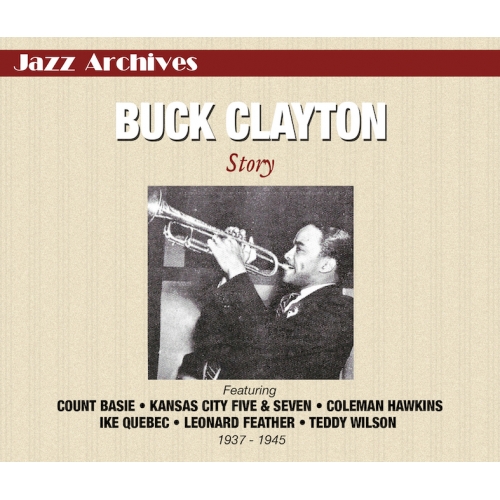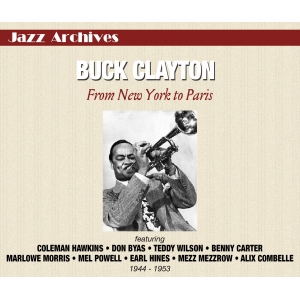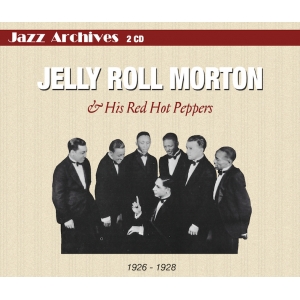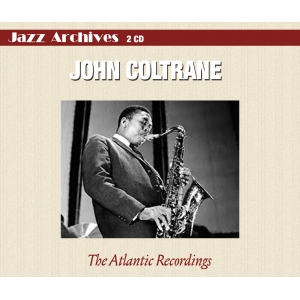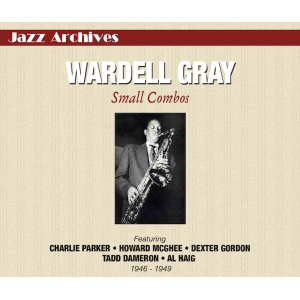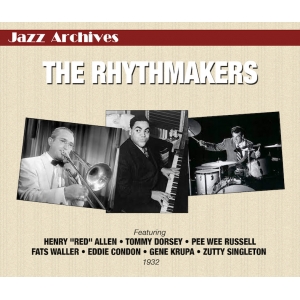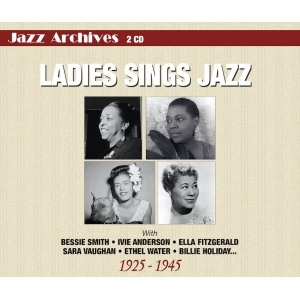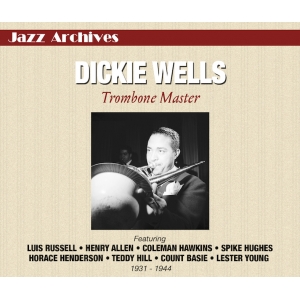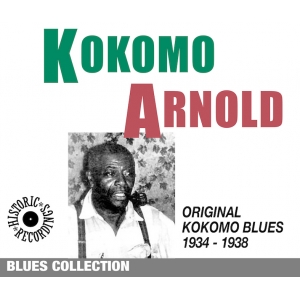BUCK CLAYTON / STORY
VOUS RECEVREZ UN BON D'ACHAT 10% À PARTIR DE 40 € DE COMMANDE
BUCK CLAYTON STORY 1937 - 1945
With Count Basie, Coleman Hawkins, Tedddy Wilson, Kansas City Five & Seven and others...
1 SWINGING AT THE DAISY CHAIN
2 SMARTY
3 BLUES IN THE DARK
4 SONG OF THE ISLANDS
5 EASY DOES IT
6 LOVE JUMPED OUT
7 UNDECIDED BLUES
8 FEEDIN' THE BEAN
9 GOIN' TO CHICAGO BLUES
10 FIESTA IN BLUES
11 ROYAL GARDEN BLUES
12 BUGJE BLUES
13 SUGAR BLUES
14 ST. LOUIS BLUES
15 GOOD MORNING BLUES
16 DESTINATION K.C.
17 A SHANTY IN OLD SHANTY TOWN
18 SCRAM !
19 CUP-MUTE CLAYTON
20 BLUES TOO
Wilbur "Buck" Clayton est né le 12 novembre 1911 à Parsons (Kansas). A 18 ans, il part pour la Californie et joue vers 1932 dans l'orchestre d'Earl Dancers. Il fonde ensuite son propre orchestre que le pianiste Teddy Weatherford fait venir en Chine. C'est ainsi qu'avec "The 14 Gentlemen from Harlem", il joue pendant deux ans à Shanghaï!
De retour en Californie, il s'embarque pour New York pour répondre à l'invitation du chef d'orchestre Willie Bryant mais, en chemin, il s'arrête quelques jours à Kansas City pour voir son ami, le grand saxo-ténor Herschel Evans qui venait d'entrer dans le nouvel orchestre que montait Count Basie. Bien naturellement, il prend sa trompette pour venir "jammer" au Reno Club avec son copain Herschel et les gars de Count Basie. Ce dernier, qui venait de perdre son trompettiste-vedette Oran "Hot Lips" Page (voir EPM/Jazz Archive 158892) et Buck s'étant tellement plu à jouer au Reno Club, Basie et Herschel n'eurent pas beaucoup à insister pour qu'il entre dans l'orchestre et oublie New-York et la proposition de Willie Bryant! C'était le début d'une merveilleuse complicité entre Buck et la musique de Mr. William Basie!
Trompette brillant et émouvant, mais aussi arrangeur de grand talent, Buck devint en sorte le directeur musical de la formation. Lorsque certains musiciens de l'orchestre avaient l'idée d'un thème, d'un riff, ils le proposaient à Buck qui aussitôt le mettait en forme et bâtissait une orchestration qui grossissait le répertoire de l'orchestre.
Entré en 1936 chez Basie, il fallut que le lendemain de son anniversaire, le 13 Novembre 1943, l'Oncle Sam veuille de lui comme soldat et le mobilise, pour que s'arrête officiellement sa collaboration avec le Count. Mais Buck, cantonné au camp Kilmer (New Jersey) profitait de toutes les occasions pour venir jouer à New York, tout proche, avec ses amis; c'est ainsi qu'il participa à des séances d'enregistrements, alors qu'il était toujours mobilisé! Rendu à la vie civile en 1946, il joue avec la troupe du Jazz At The Philarmonic, puis forme des petits orchestres, vient avec l'un d'eux en France en 1949, joue avec Jimmy Rushing, revient en France en 1953 avec Milton Mezzrow et par la suite fera de fréquents séjours dans notre pays qu'il aimait tant, où il comptait tant d'admirateurs et dont il parlait la langue avec élégance.
En véritable ambassadeur de la musique de Count Basie et de Kansas City, Buck Clayton durant toute sa carrière continua à faire vivre et à populariser ce tonique climat musical, que ce soit dans ses compositions, ses arrangements ou ses enregistrements. Aussi, n'est-il pas étonnant de le retrouver, à chaque fois qu'il le pouvait, avec ses anciens compagnons, ceux qui étaient le plus marqués, le plus ancrés dans cette tradition : les Buddy Tate, Dickie Wells, Earl Warren, Jimmy Rushing, Walter Page, Freddi Greene, Jo Jones, bref, l'élite de l'orchestre du Count Basie de l'époque mythique!
L'état de ses lèvres l'obligea vers les années 70 à renoncer à son instrument, mais tout au long des années 80 on le trouve encore dirigeant de grandes formations qui utilisaient largement ses propres arrangements. C'est peu après son 80ème anniversaire qu'il nous quitte en s'éteignant durant son sommeil.
Nous avons sélectionné une forte proportion de titres de l'orchestre de Count Basie, mais Buck Clayton n'en était-il pas un des plus importants solistes ainsi que le principal arrangeur-maison depuis le départ d'Eddie Durham?
Buck est un trompettiste au jeu délicat et nuancé, mélodieux mais aussi très incisif et doué d'un pouvoir créateur exceptionnel. Ses solos se déroulent avec aisance, avec logique, avec grâce, pourrait-on dire. Il possède un des plus beaux sons de trompette, et plus les années ont passé plus il s'est rapproché de Louis Armstrong dont l'influence a été de plus en plus grande sur son jeu (Scram). Sa sonorité ample, large, chaude est embellie par un vibrato d'une extrême sensibilité, particulièrement perceptible dans la belle série gravée en Juillet 1942 avec Don Byas et Count Basie : Sugar Blues, St.Louis Blues.
Buck utilisait les sourdines avec élégance, notamment la "cup-mute" qu'il affectionnait particulièrement (Song Of The Islands, Good Morning Blues). Lorsqu'il jouait de la sourdine "wa-wa" c'était avec retenue et délicatesse, jamais en force : Fiesta In Blue, Undecided Blues, Feedin' The Bean, ce dernier morceau avec un tonitruant et dominateur Coleman Hawkins comme invité de l'orchestre. Buck était aussi un exceptionnel interprête de blues. Comme le disait si joliment son ami, "son frère" Dickie Wells : "Il y a les grands chanteurs de blues certes, mais il y a aussi les "blues-singers without words, c'est-à-dire les instrumentistes qui jouent le blues avec l'intensité et l'émotion des meilleurs chanteurs", et de citer Buck Clayton aux côtés des Lips Page, Johnny Hodges, Buddy Tate, Tricky Sam, Vic Dickenson, Pete Johnson…
Swinging At The Daisy Chain est le premier disque de Buck comme soliste, il y montre sa maturité et sa maîtrise dans l'emploi si personnel de la sourdine! Herschel Evans ne joue que 8 mesures de ténor, mais tellement chargées d'émotion, de passion, de véhémence qu'il m'est impossible de ne pas le souligner, de même que sa vibrante intervention de Smarty!
Pour Destination K.C., le Sergent Buck Clayton encore sous les drapeaux au Camp Shanks, retrouve ses anciens partenaires et démontre aisément, au cours de deux splendides chorus, que pendant sa mobilisation il n'avait rien perdu de son invention et de sa vigueur. Dans Scram son solo d'une conception et d'une construction exemplaire est développé avec une remarquable aisance, sans que son inspiration ne faiblisse un seul instant! Il en est de même tout au long du réjouissant Shanty Town avec Coleman Hawkins, Slam Stewart et Teddy Wilson. Toute sa sensibilité pour exposer et broder sur un thème mélodieux s'exprime dans Song Of The Islands de même que dans Fiesta In Blue qui lui est entièrement consacré et où son jeu possède une envolée et un souffle dignes des plus grands!
L'importance de Buck comme arrangeur nous semble avoir été souvent sous-estimée, voire même ignorée. C'était un éminent arrangeur qui a enrichi le répertoire de Count Basie de nombreux morceaux qui comptent tous parmi les réussites de cette formation. Son écriture simple, directe, allait à l'essentiel, à ce que recherchait Count Basie : un tremplin pour que son orchestre atteigne l'euphorie et le swing! C'est ce que résumait si bien Dickie Wells en disant : "Buck, dans ses arrangements, savait exactement ce qu'il fallait écrire pour mettre les musiciens de l'orchestre à l'aise".
De sa plume, nous avons ici : Blues In The Dark où le passage du mode mineur avec son solo de trompette, au mode majeur avec le vocal de Jimmy Rushing est d'un effet saisissant et bien venu, avec retour au mineur pour la trompette sur un fond orchestral dramatique. Egalement Goin' To Chicago Blues, morceau célèbre qui participa largement à la gloire de Jimmy Rushing et Count Basie! Son alerte Love Jumped Out est un de ses jump tunes du genre "tout-pour-le-swing", tels que Count Basie en jouait souvent au cours des années 39 à 45. Savez-vous aussi que le talent de Buck comme arrangeur, a été reconnu par le plus illustre d'entre eux : Duke Ellington, qui avait enregistré plusieurs orchestrations de Mr Clayton au cours des années 40?. Une référence!
Que ce soit dans les rangs de l'orchestre de Count Basie ou avec des partenaires prestigieux, ou au cours des multiples séances qu'il a dirigé à partir de 1950, Buck "Cat Eyes" Clayton a donné au Jazz, de nombreux chefs-d'œuvre, en apportant cette chaleur et cette élégance qui, entre autres qualités, le caractérisaient si bien!
Jacques Morgantini
Wilbur “Buck” Clayton was born on 12 November 1911 in Parsons, Kansas. When he was eighteen he left for California and around 1932 played in Earl Dancers’ orchestra before setting up his own band, “The 14 Gentlemen From Harlem”. Teddy Weatherford, the pianist, arranged for them to go to China which is why Buck found himself playing a residency in Shanghai for a couple of years!
After returning to California he was invited to New York by the band leader Willie Bryant, but he stopped off on the way in Kansas City to visit his old friend, the great tenor saxophonist Herschel Evans who had just joined Count Basie’s new orchestra. Naturally Buck took his trumpet along to the Reno Club to jam with Herschel and Basie’s men. As the Count had just lost his star-trumpeter Oran “Hot Lips” Page (see EPM/Jazz Archive 158892) and as Buck so much enjoyed playing at the Reno Club it did not take Basie and Herschel long to persuade him to join the orchestra and forget New York and Willie Bryant’s offer. And so began that marvellous complicity between Buck and the Basie band.
Not only a brilliant and stirring trumpeter but also an immensely talented arranger, Buck became a sort of musical director for the band. Whenever one of the musicians came up with an idea for a theme or a riff he took it to Buck who immediately licked it into shape, thus adding yet another orchestration to the band’s repertoire.
This collaboration lasted from 1936 to November 1943 when Clayton was drafted into the army the day after his 33rd birthday. However, he was lucky enough to be stationed at the Kilmer camp in New Jersey and seized any opportunity that offered to get to nearby New York and play with his friends. Hence he was able to take part in recording sessions even though he was still serving in the US army! Back in Civy Street in 1946 he played with the Jazz At The Philharmonic formation, then formed several small bands, bringing one of them to France in 1949, played with Jimmy Rushing and returned to France in 1953 with Milton Mezzrow. Later on his trips to France became and more frequent for he loved the country, spoke the language fluently and had many fans there.
Throughout his career, in his role as a true ambassador for the music of Count Basie and Kansas City, Buck Clayton continued to promote and popularise this musical style, whether through his compositions, his arrangements or his recordings. So it is hardly surprising to find him playing whenever possible with his old companions, those who had been the most influenced by and remained the most attached to this tradition: Buddy Tate, Dickie Wells, Earl Warren, Jimmy Rushing, Walter Page, Freddie Green, Jo Jones — in short the cream of Count Basie’s orchestra at its best.
In the 70s problems with his lips forced him to give up playing but throughout the 80s he continued to lead big bands which for the most part used his own arrangements. He died in his sleep in December 1981 shortly after his 80th birthday.
That the present selection includes a preponderance of titles by Count Basie’s orchestra is a tribute to the fact that Buck Clayton was one of the Count’s most important soloists and the band’s principal arranger after Eddie Durham left.
Buck’s delicate and finely-shaded trumpet playing is melodic yet incisive at the same time and reveals exceptional creative power while his solos are developed with a graceful, logical ease. Over the years his beautifully burnished tone became increasingly closer to that of Louis Armstrong who had the greatest influence on his playing (Scram). His full, rounded, warm tone is enhanced by an extremely sensitive vibrato, particularly evident on the attractive session cut in July 1942 with Don Byas and Count Basie: Sugar Blues, St. Louis Blues.
Clayton’s muting was always discreet, never forced. The cup-mute was a particular favourite of his (Song Of The Islands, Good Morning Blues) and his restrained and delicate use of the “wa-wa” mute can be heard on Fiesta In Blue, Undecided Blues, Feedin’ The Bean, with an explosive and dominant Coleman Hawkins guesting on the latter. Buck was also a wonderful exponent of the blues. As his friend and “brother”, Dickie Wells, put it: “Of course there are great blues singers, but there also blues singers without words, that is musicians who play the blues with the same intensity and feeling as the best singers”, ranking Buck Clayton alongside “Hot Lips” Page, Johnny Hodges, Buddy Tate, Tricky Sam, Vic Dickenson, Pete Johnson …
Swinging At The Daisy Chain, Buck’s first record as a soloist, reveals his maturity and personal mastery of the mute. And although Herschel Evans plays only 8 bars on tenor, these are so full of feeling, passion and vehemence that they are as worthy of note as his lively intervention on Smarty.
On Destination K.C. Sergeant Buck Clayton, still in uniform, is back with his old partners and the two splendid choruses show that his stint in the army had in no way affected his inventive powers or vigour. His exemplary solo on Scram is developed with remarkable ease and his inspiration never falters. The same goes for the entertaining Shanty Town with Coleman Hawkins, Slam Stewart and Teddy Wilson. His ability to embroider on a melodic theme is evident on Song Of The Islands and Fiesta In Blue, the latter given over entirely to Buck who takes off in a manner worthy of the greatest musicians!
Buck Clayton’s importance as an arranger has often been underrated, even ignored. And yet he was an outstanding arranger whose talents provided Count Basie’s orchestra with many of its most successful titles. His simple, direct approach was exactly what Basie was looking for: a springboard from which the band could take off, reaching euphoric heights of swing. Dickie Wells summed it up perfectly: “Buck knew exactly how to write his arrangements so that the musicians in the band felt completely at ease with them”.
The present compilation includes several examples of his orchestration: Blues In The Dark with its startlingly brilliant change of key from Clayton’s trumpet solo in minor to Jimmy Rushing’s vocal in major and then back to the trumpet in minor with an orchestral backing. Also the well-known Goin’ To Chicago that played such an important role in establishing the fame of Jimmy Rushing and Count Basie. His lively Love Jumped Out is in the style of one of those swinging jump tunes that Basie so often treated us to between 1939 and 1945. Buck Clayton’s talent as an arranger was even recognised by the Duke himself who recorded several of his orchestrations during the 40s.
Jazz owes many of its masterpieces to Buck “Cat Eyes” Clayton who, whether as sideman in the Basie orchestra or playing with famous musicians or during the numerous sessions he led from 1950 onwards, never failed to show that warmth and sensitivity that were an integral part of the man himself.
Adapted from the French by Joyce Waterhouse

